Companion planting is like throwing a gardening party where everyone’s invited! It enhances nutrient uptake, with tomatoes and basil throwing a delicious flavor fest together. Marigolds stand guard as natural pest controllers, while diverse plant buddies boost pollination, attracting buzzing bees like a sweet perfume. Plus, it maximizes your garden space brilliantly—tall plants offer cozy shade to smaller ones! Curious about how these plant pals can supercharge your garden? Stick around, and you’ll discover even more!
Enhances Nutrient Uptake
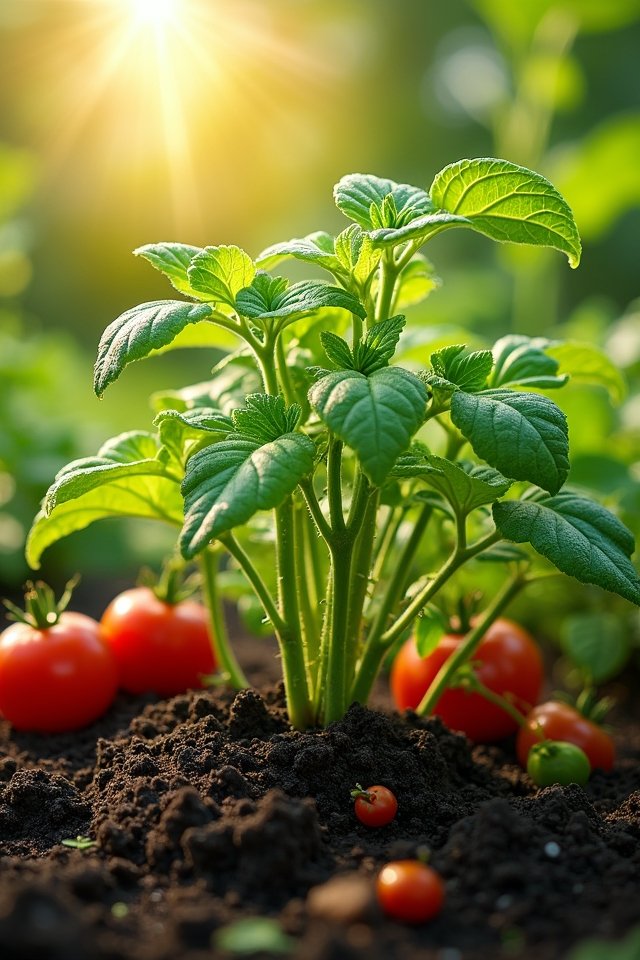
When you plant different crops together, you’re not just creating a beautiful garden; you’re enhancing nutrient uptake like a pro! Imagine this: tomatoes and basil cuddling side by side. They share nutrients like best friends at a buffet! Basil helps tomatoes thrive by releasing compounds that keep pests away. Together, they create a mini-ecosystem that promotes healthy growth and vibrant flavors.
But wait, there’s more! Carrots and onions make a dynamic duo too. The onions’ scent confuses carrot flies, while the carrots help aerate the soil. Isn’t nature amazing? By planting these companions, you’re not just growing food; you’re innovating your garden’s potential! So grab those seeds and start mixing! After all, who knew nutrient uptake could be so exciting?
Natural Pest Control

If you’ve got a garden going, you’re already on the path to success with those nutrient-happy companions! Imagine planting marigolds alongside your veggies. Those bright blooms aren’t just pretty; they’re like nature’s bouncer, keeping pesky pests at bay. Their scent confuses aphids and other nuisances, sending them packing!
You can also try teaming basil with tomatoes. Not only does basil enhance flavor, but it also helps deter hornworms! It’s a win-win!
And don’t forget about planting nasturtiums—those feisty flowers attract aphids away from your prize plants. It’s like a protective shield, allowing your garden to thrive. So, when you get creative with combinations, you’re not just gardening; you’re orchestrating a symphony of natural pest control! 🌱✨
Improved Pollination
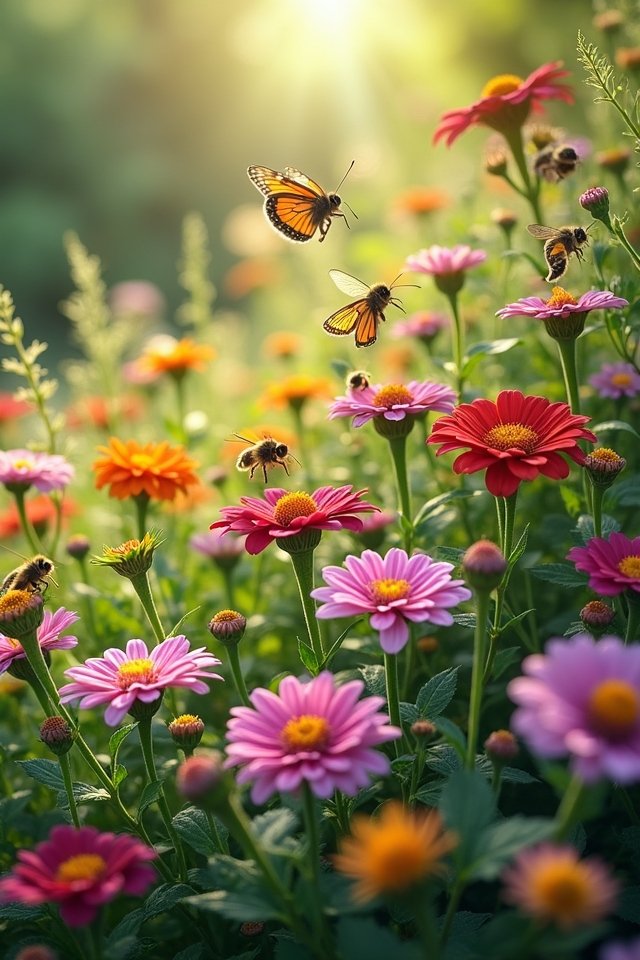
As you stroll through your garden, you’ll likely notice a delightful buzz filling the air—it’s nature’s little helpers at work! When you adopt companion planting, you not only enhance your plants but also attract more pollinators. How can you do this?
- Mix Flowers with Fruits: Colorful blooms like sunflowers invite bees right to your tomatoes.
- Use Scented Herbs: Basil and lavender share delightful aromas that draw in butterflies and bees, giving your garden a vibrant life!
- Plant Diversity: A variety of plants creates a buffet for pollinators, ensuring they stick around to pollinate more than just one flower.
With this buzzing teamwork, you’ll grow a fruitful garden that maximizes potential and delights the senses! How exciting is that?
Maximizes Space Efficiency
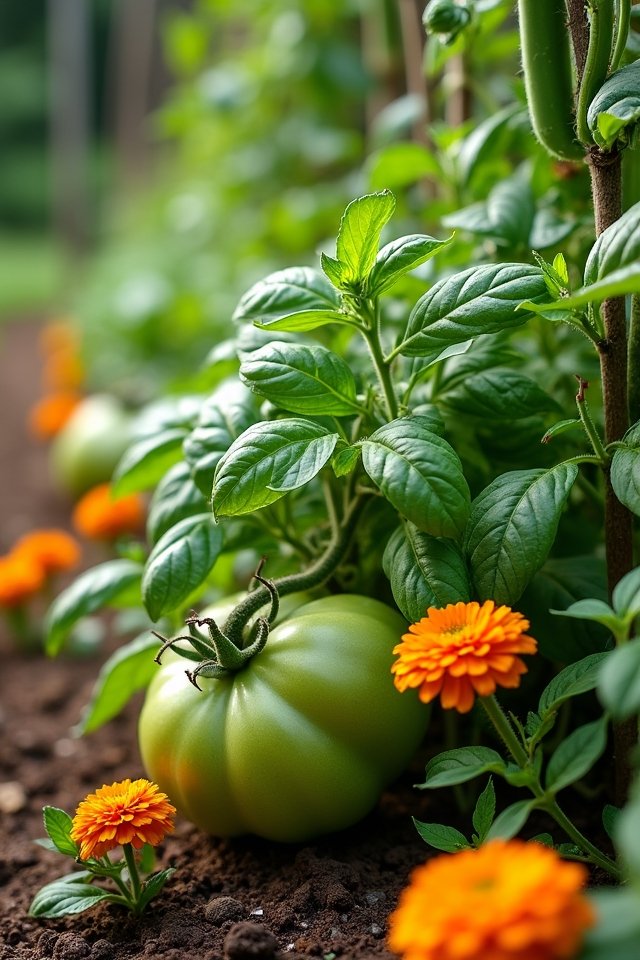
Garden space can often feel like a battleground, especially when you’re trying to fit in all your favorite plants. But fear not! Companion planting can turn that cramped chaos into a beautifully orchestrated symphony! Imagine this: tall sunflowers offering shade to delicate lettuces below, while fragrant basil cozies up next to your tomatoes. You’re not just stacking plants; you’re creating a mini-ecosystem! The art of mixing smartly can take your tiny plot from plain to phenomenal. Why let space go to waste, when you can play matchmaker with your veggies? Got a corner full of peas? Add climbing beans and let them twine together like they’re at a garden dance party! Maximizing space has never felt so innovative and fun!
Encourages Biodiversity

Biodiversity can be your garden’s best friend! When you adopt companion planting, you invite a symphony of organisms to play in your soil. More plant types can lead to a more vibrant ecosystem. Here are three amazing benefits of promoting biodiversity in your garden:
- Natural Pest Control: Diverse plants attract beneficial insects, which keep harmful pests at bay—think ladybugs as your garden’s tiny superheroes!
- Soil Health: Different root structures and nutrients create a rich tapestry beneath the surface—think of it as nature’s underground buffet!
- Resilient Growth: Varied plant life increases resilience against environmental changes—like sending in the reinforcements during a storm!
Isn’t it exciting to turn your garden into a lively, balanced world? So, get planting and watch your garden thrive!
Reduces Plant Diseases
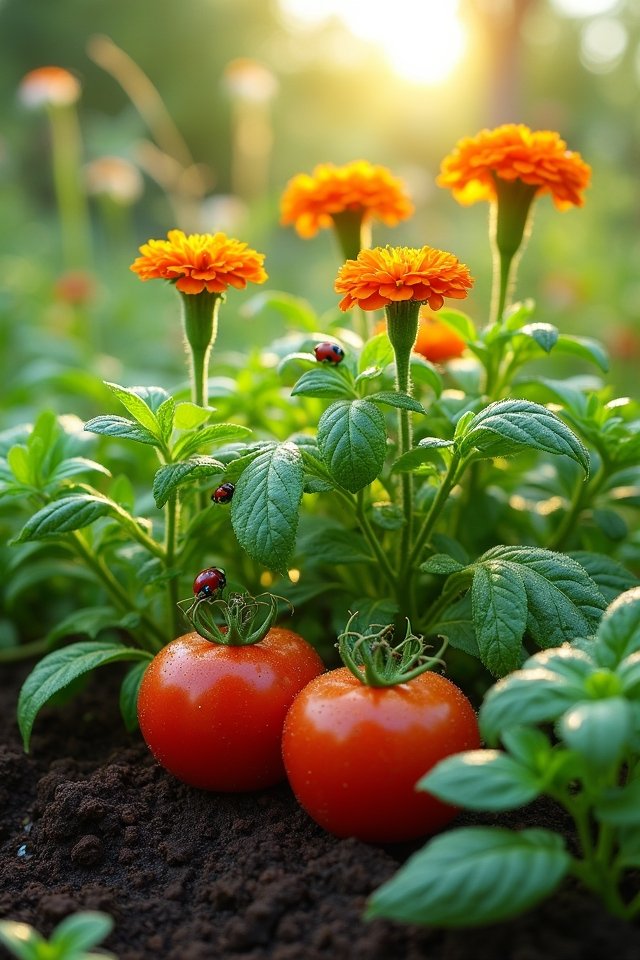
When you mix different plants together, you’re not just decorating your garden; you’re crafting a powerful shield against plant diseases! Imagine putting garlic next to your roses—garlic’s natural compounds can chase away pesky aphids. It’s like having a tiny bodyguard for your flowers!
Similarly, planting marigolds alongside your veggies can deter nematodes, almost like having your very own plant ninjas. You’ll notice that diverse plant buddies create an ecosystem that disrupts disease cycles.
Plus, when plants share nutrients, they’re just happier and healthier! It’s a win-win! So, why not get adventurous? Mix those colors, scents, and flavors, and watch your garden transform into a vibrant fortress, protecting your green treasures from unseen threats! How cool is that?
Helps With Weed Suppression
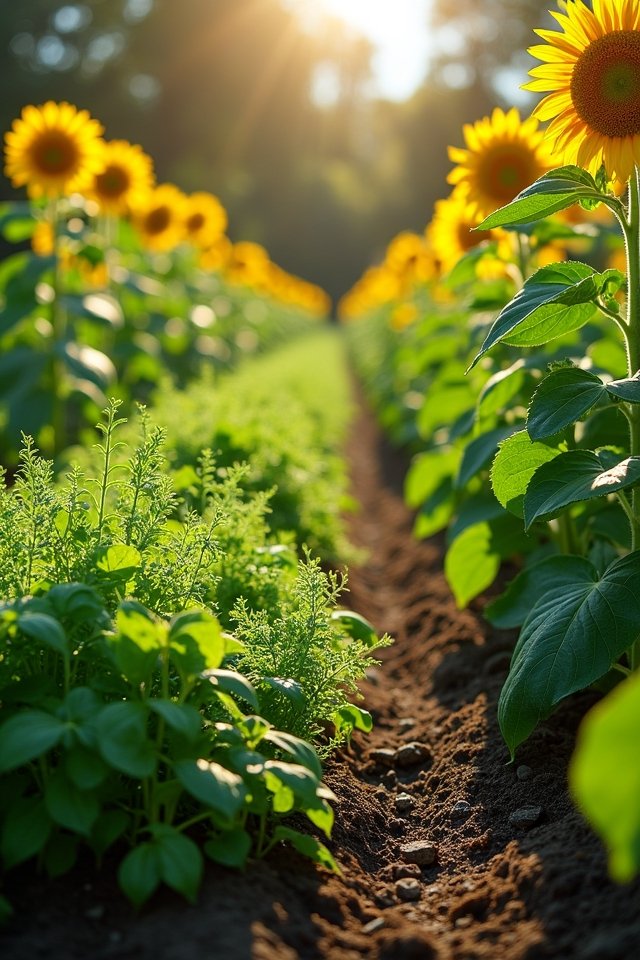
Sure, while you’re busy defending your plants against diseases, there’s another stealthy enemy in the garden you need to watch out for—weeds! These pesky intruders can sap nutrients and steal sunlight from your beloved plants. But companion planting comes to the rescue!
Here’s how it helps with weed suppression:
- Crowd Control: Some plants are like party bouncers, filling the space to deter weeds from getting a foothold.
- Shady Business: Larger plants create shade, making it tough for weeds to photosynthesize!
- Diversity Wins: A mix of species can confuse weeds, making it harder for them to thrive.
Increases Yield Quality
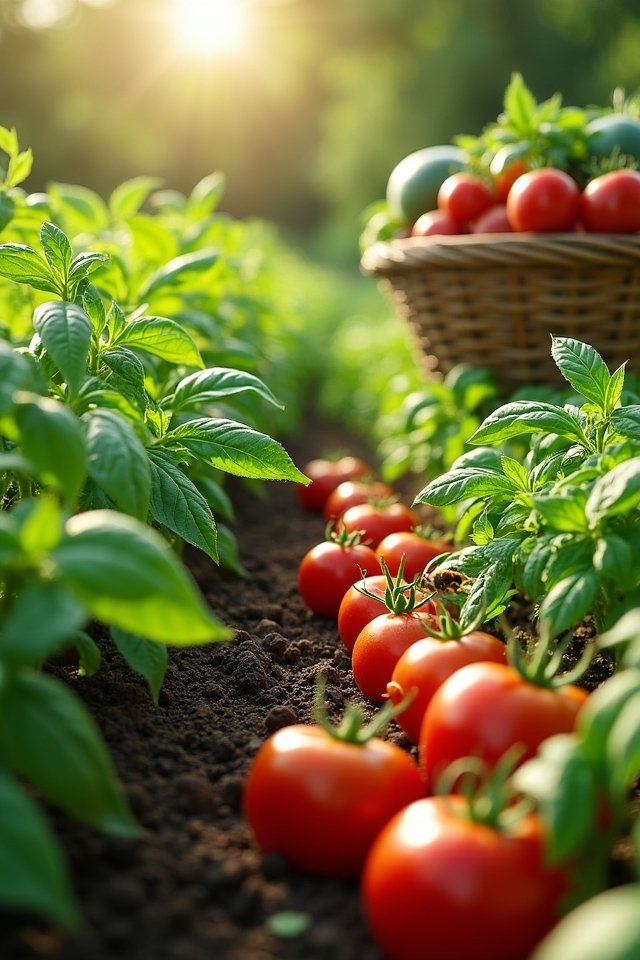
There’s nothing quite like harvesting a bountiful garden, but did you know that companion planting can take your yield quality to the next level? Imagine plucking ripe tomatoes that burst with flavor, thanks to their leafy companion basil! Pairing plants wisely can enhance taste and texture, making your veggies the envy of the neighborhood. Think of it as a dinner party, where each plant brings its own special dish to the table, creating a delightful culinary symphony! For instance, carrots love to mingle with onions, as each helps the other thrive and taste better. You’ll enjoy tastier food, and that fresh aroma will have you feeling like a gardening rockstar! So, why not elevate your harvest?
Promotes Soil Health
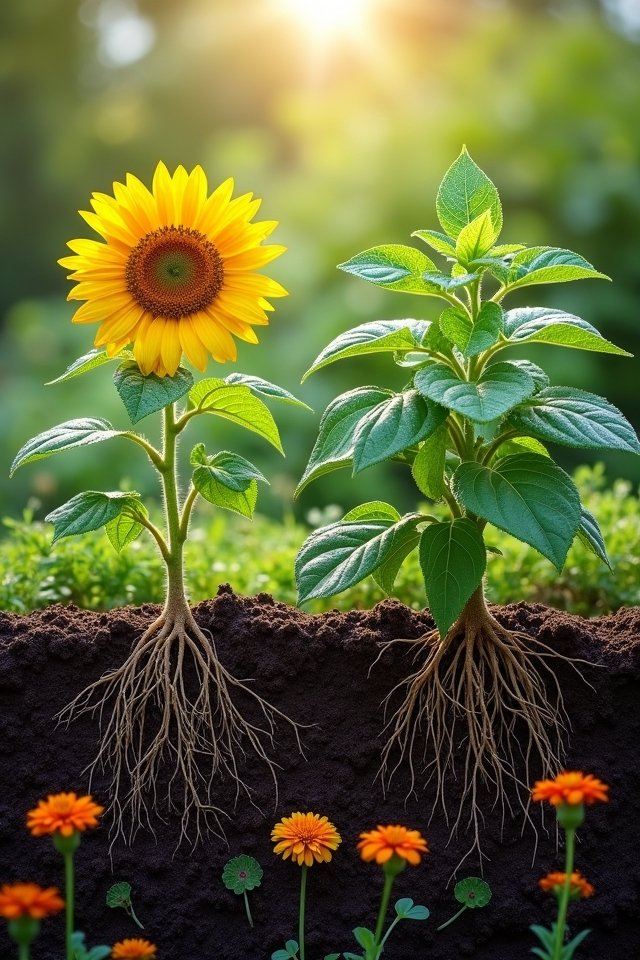
While it might seem like just a gardening trend, companion planting does wonders for your soil health! By selecting the right plant buddies, you’ll transform your garden into a thriving ecosystem. Here are three ways this innovative practice benefits your soil:
- Nutrient sharing: Some plants, like legumes, fix nitrogen in the soil, providing essential nutrients for others.
- Pest deterrence: Certain companions naturally repel pests, reducing the need for chemical interventions that can harm the soil.
- Improved structure: Deep-rooted plants, like carrots, can aerate the soil, creating a better environment for beneficial microbes.
Creates a Sustainable Ecosystem
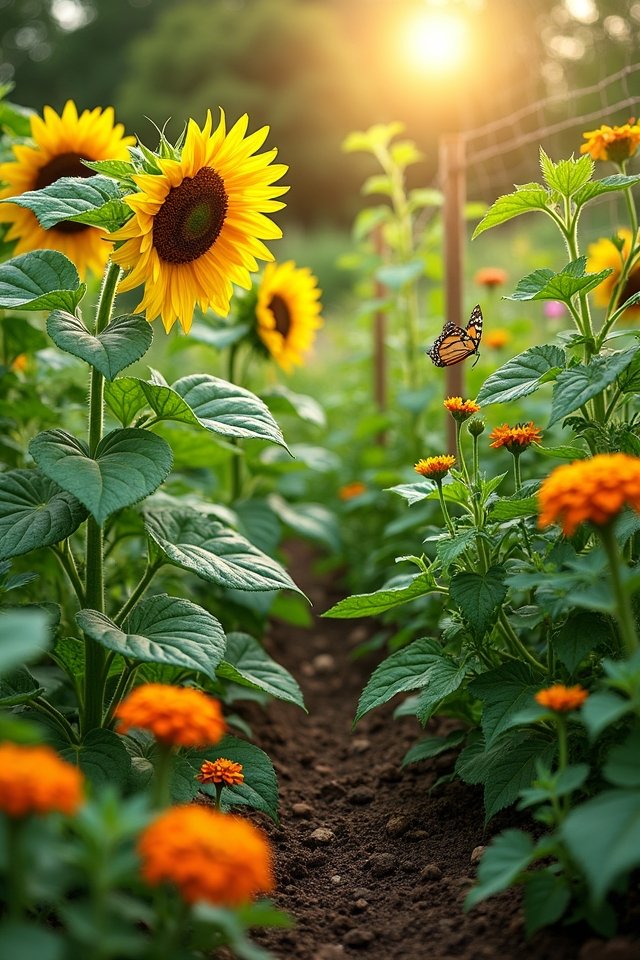
When you think about gardening, wouldn’t you want to create a vibrant tapestry of life right in your backyard? By practicing companion planting, you won’t just grow plants; you’ll cultivate a lively ecosystem! Think about adding marigolds next to your tomatoes. Those cheerful blooms attract beneficial insects, keeping pests at bay. Or pair basil with peppers—the aromatic herb can actually enhance the peppers’ flavor while repelling unwanted visitors. It’s like hosting a dinner party where everyone brings a delightful dish! This collaboration between plants nurtures diversity, inviting pollinators and microbes that thrive in this harmonious setting. So, why not transform your garden into a bustling community? You’ll be amazed at how nature rewards your efforts with an abundance of flavors and life!
Frequently Asked Questions
What Are the Best Companion Plants for Tomatoes?
When it comes to growing tomatoes, you’re in for a treat with companion plants! Try basil—its aromatic leaves will make your tomato plants happy and flavorful! You might also consider marigolds; they’ll bring a splash of color and deter pesky pests. And hey, throw in some garlic for a punchy companion that helps keep those garden villains at bay! It’s like a garden party where everyone’s invited to thrive! Isn’t that cool?
Can Companion Planting Be Done in Container Gardens?
Absolutely, you can totally rock companion planting in container gardens! Imagine this: plants packed into just 4 square feet can yield up to 20% more food—mind-blowing, right? Pair fragrant basil with your tomatoes for a delicious aroma and pest deterrence. Plus, vibrant marigolds can splash color while keeping pesky bugs at bay. Isn’t it amazing how a little coordination can transform your garden? So, get those pots dancing together and watch your greens thrive!
How Does Companion Planting Affect Crop Rotation?
Companion planting can totally transform your crop rotation game! It’s like giving Mother Nature a sidekick. When you pair plants wisely, like tomatoes with basil, you’ll boost nutrient uptake and naturally repel pests. Imagine the thrill of seeing healthier, thriving crops! Plus, rotating these clever combinations helps prevent soil depletion and keeps your garden lively. So, ready to make your garden a superstar? It’s time to mix and match for a flourishing harvest!
Is There a Specific Season for Companion Planting?
Absolutely, there’s a perfect season for companion planting! Spring’s your best buddy, with its warm sun and fresh soil inviting all those delightful plant pairings. Imagine tomatoes dancing with basil, or carrots cozied up with onions! You’ll find a fabulous synergy in your garden, creating mini ecosystems. Don’t forget, each plant’s needs vary, so check your local climate too. Isn’t it exciting to watch nature’s teamwork bloom? Yes, it really is!
What Common Mistakes Should I Avoid With Companion Planting?
When you’re diving into companion planting, watch out for a few common blunders! Don’t crowd your plants; they need space to flourish, just like you need room to breathe! Be careful with plant pairings, too—mixing incompatible species can lead to disaster! And remember, it’s about balance; over-fertilizing can spoil the fun. Keep it simple, ask questions, and most importantly, enjoy the vibrant patchwork of life your garden creates! Happy planting!


